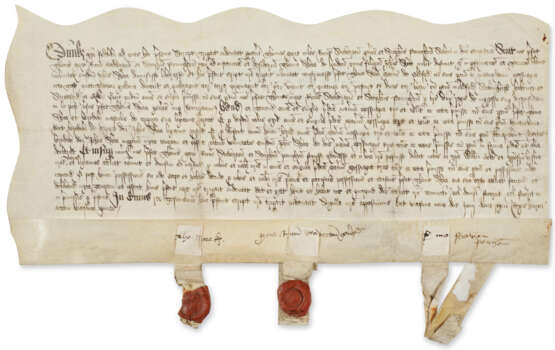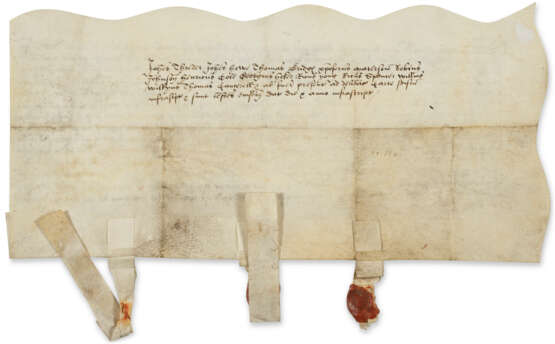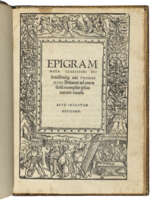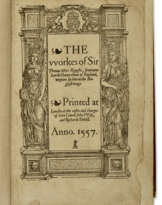ID 1471988
Lot 65 | London land indenture
Estimate value
$ 25 000 – 35 000
Ink on vellum, 170 x 400 mm, scribal hand, signed at the foot by Thomas More as well as by Staverton and Ponchon. The signatures each written across the upper parts of parchment tags bearing their red wax seals (More's seal chipped, Ponchon's lacking, a little mounting residue to Ponchon's tag). One part of a tripartite indenture, indented at head and on left, contemporary annotation on verso recording the names of witnesses. Custom chemise and red morocco box. Provenance: Christie's, 21 June 1989, lot 108 – Sotheby's New York, 17 December 1992, lot 179.
An indenture signed by Thomas More for a significant property in east London. The transaction covers the manor of Old Ford as well as 14 messuages, 8 tofts, 14 gardens, 240 acres of land, 50 acres of meadow, 24 acres of pasture and 2 acres of woods in Old Ford, 'Stabinghith' [Stepney], Hackney, and Stratford-att-Bowe, all lying just east of the City of London. It was a response to the death without heirs, on 24 March 1533, of Edmund Shaw of Lincoln’s Inn, to whom the estate had been bequeathed, in remainder after his mother’s death, by the will of his father Sir John Shaw in 1503. The grantors recite that they have acquired the manor from Thomas Shaw by common recovery, presumably in order to bar the entail created by his father’s will; they then proceed to grant it back to him on similar trusts.
This document is dated a year after More refused to sign the Oath of Supremacy and surrendered the Lord Chancellor's seal and in the same month as he declined to attend the coronation of Anne of Boleyn. It was the latter act that may have sealed his fate with King Henry VIII and he was arrested in April 1534 and executed on 6 July 1535. More's crest is on his seal, which depicts the profile of a stereotyped "Moor" (a pun on his own name).
The signatory Richard Staverton is presumably More’s brother-in-law (the husband of his sister Jane). He was More’s fellow at Lincoln’s Inn, to which they were both admitted on 12 February 1496. Stephen Puncheon, almost certainly a lawyer, was perhaps related to Nicholas Puncheon, one of the sheriffs of London in 1533 (Baker Men of court 1233, 1459).
Sir John Shaw [Shaa] (c.1455–1503) is recorded as a working goldsmith who made significant sales of plate and jewelry to both Edward IV and Henry VII. However, his relationship with the latter became much more than that of a craftsman selling his wares, for the Great Chronicle of London refers to "the favour that he stood in with the king and queen and many other estates of this land" (Thomas and Thornley, 320). The Great Chronicle describes Shaw as a man "of a sharp wit" and records how he made himself available during afternoons to citizens who had minor legal issues, giving them free advice and help. In his will, Shaw left the manor of Old Ford to his wife Margaret for life with successive remainders to his sons Edmund, Reynold and Thomas, and an ultimate remainder to his own heirs general. Edmund Shaw was admitted to Lincoln’s Inn in 1510, was declared a lunatic in 1527 (TNA E 150/482/3) and died on 24 March 1533 without male issue. (ODNB, Baker)
According to Rare Book Hub, no document signed by Thomas More has been sold at international auction since the Spiro sale in 2003.
| Artist: | Thomas More (1478 - 1535) |
|---|---|
| Genre: | Religious genre |
| Place of origin: | England |
| Auction house category: | Letters, documents and manuscripts |
| Artist: | Thomas More (1478 - 1535) |
|---|---|
| Genre: | Religious genre |
| Place of origin: | England |
| Auction house category: | Letters, documents and manuscripts |
| Address of auction |
CHRISTIE'S 8 King Street, St. James's SW1Y 6QT London United Kingdom | |
|---|---|---|
| Preview |
| |
| Phone | +44 (0)20 7839 9060 | |
| Buyer Premium | see on Website | |
| Conditions of purchase | Conditions of purchase |








